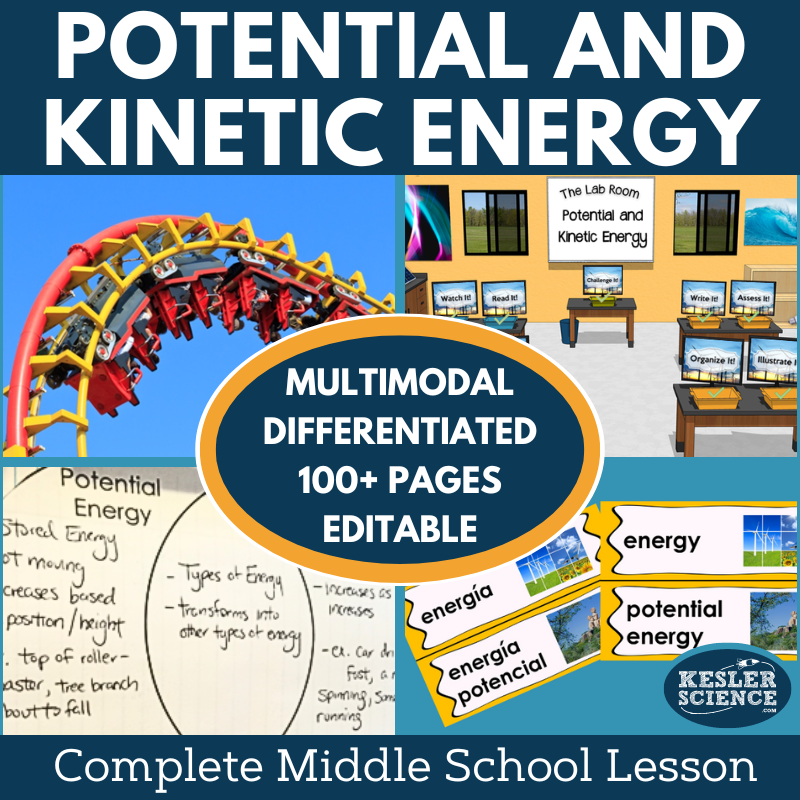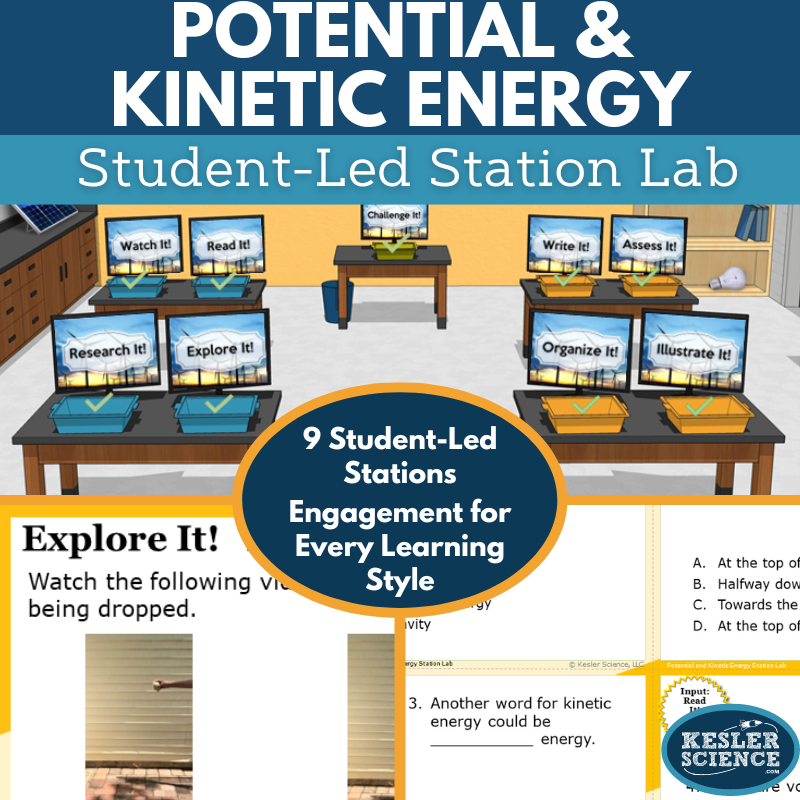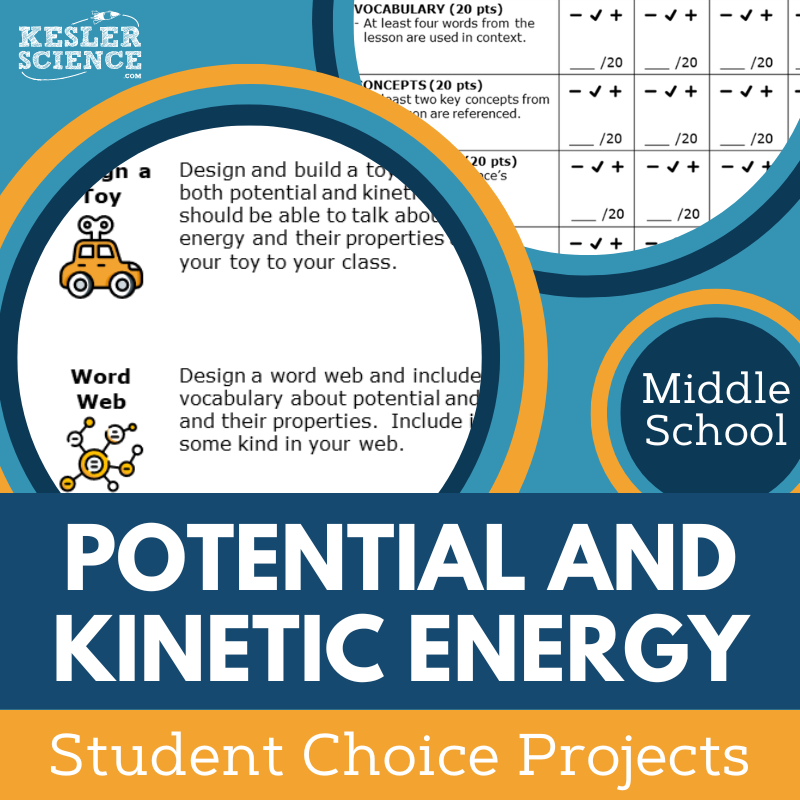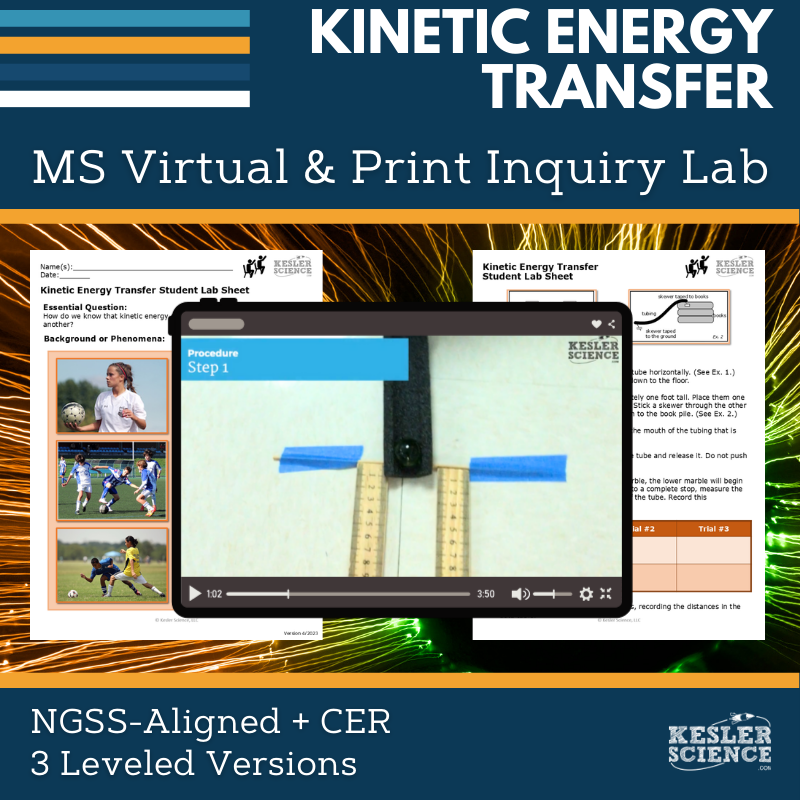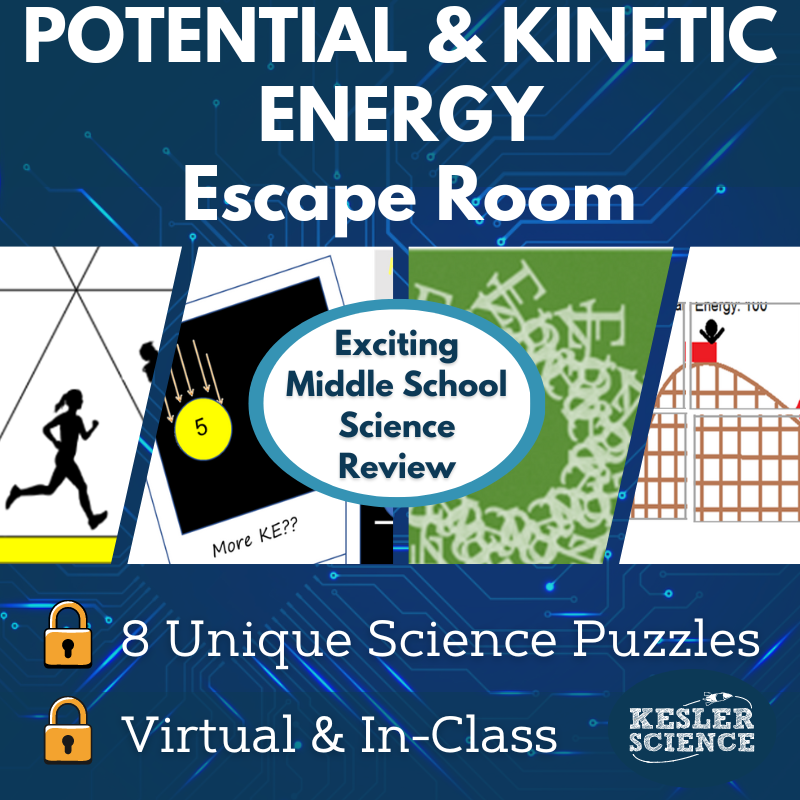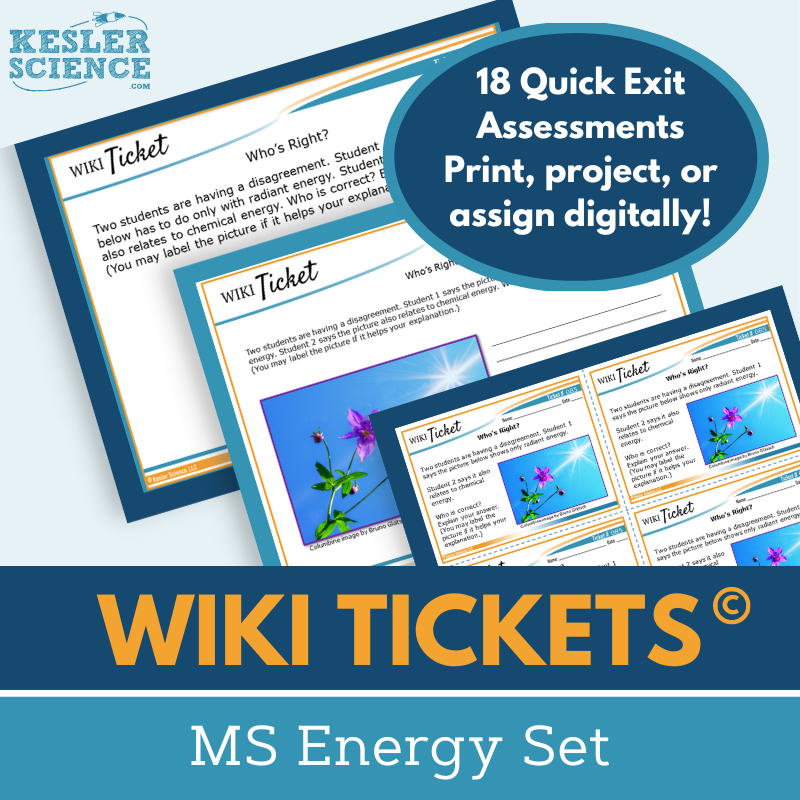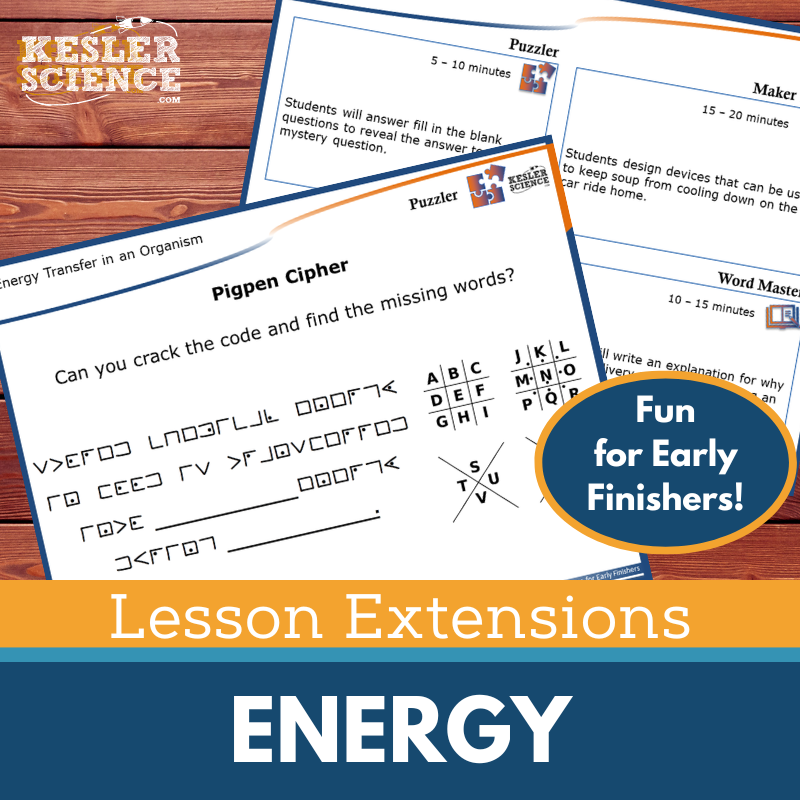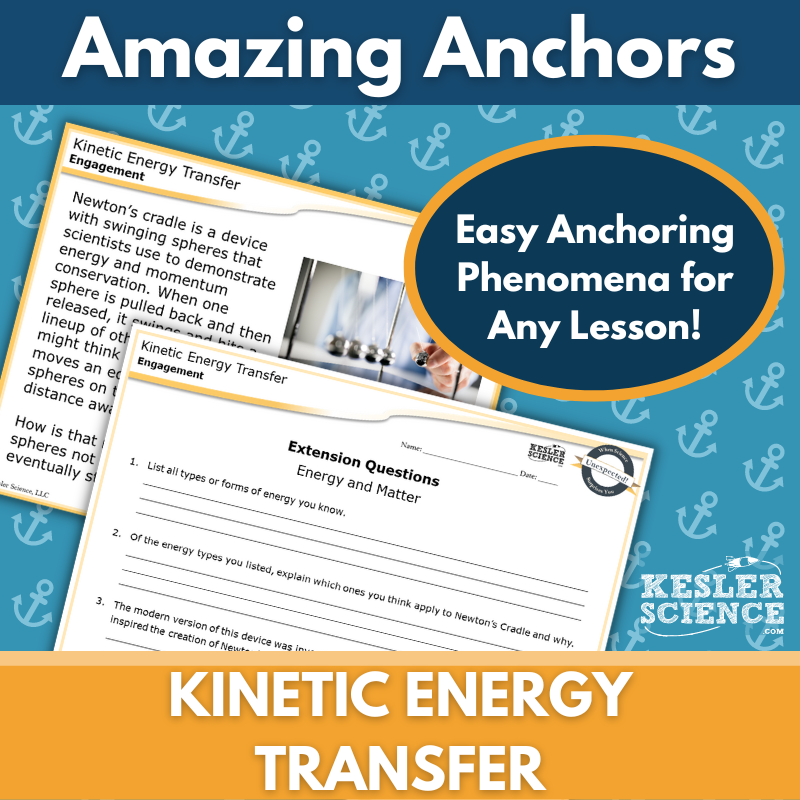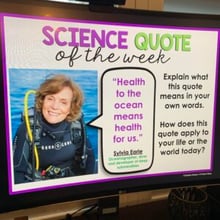Kinetic Energy Transfer Activities for Middle School Science
Help students explore kinetic energy transfer with this engaging 5E lesson aligned to NGSS MS-PS3-5. The resources below will give students a comprehensive understanding of kinetic energy transfer. All of the following materials are also included in the Kesler Science Membership.
The Kesler Science Potential and Kinetic Energy 5E Lesson is a comprehensive, student-led unit designed for middle school classrooms. It includes editable presentations, worksheets, choice projects, and assessments, all requiring minimal prep. Aligned with NGSS and TEKS, this lesson supports differentiated and multimodal learning, with printable and digital formats available. Spanish translations are included for vocabulary, reading passages, and interactive notebook pages.
Following the 5E Model, the lesson begins with engagement activities, word wall cards, and class discussions. Exploration features a differentiated, student-led station lab with nine stations, offering hands-on experiments, reading passages, research tasks, videos, and interactive exercises. Explanation includes editable PowerPoints, interactive notebooks, and note-taking templates. Elaboration provides student-choice projects to deepen understanding, while evaluation includes STAAR 2.0-aligned assessments, review questions, and worksheets for discussion or practice.
The resource is flexible for both in-person and virtual learning, ensuring accessibility and engagement for all students.
The Kesler Science Potential and Kinetic Energy 5E Lesson is a comprehensive, student-led unit designed for middle school classrooms. It includes editable presentations, worksheets, choice projects, and assessments, all requiring minimal prep. Aligned with NGSS and TEKS, this lesson supports differentiated and multimodal learning, with printable and digital formats available. Spanish translations are included for vocabulary, reading passages, and interactive notebook pages.
Following the 5E Model, the lesson begins with engagement activities, word wall cards, and class discussions. Exploration features a differentiated, student-led station lab with nine stations, offering hands-on experiments, reading passages, research tasks, videos, and interactive exercises. Explanation includes editable PowerPoints, interactive notebooks, and note-taking templates. Elaboration provides student-choice projects to deepen understanding, while evaluation includes STAAR 2.0-aligned assessments, review questions, and worksheets for discussion or practice.
The resource is flexible for both in-person and virtual learning, ensuring accessibility and engagement for all students.
The modular, student-led station lab focuses on potential and kinetic energy, engaging middle school students in a dynamic learning experience. The activity is designed to be low-prep for teachers while allowing students to take charge of their own learning. Throughout the stations, students explore and compare concepts of potential and kinetic energy in a hands-on, interactive way, with a teacher guiding rather than directing the learning process. The nine stations include all necessary resources, signage, and task cards, enabling students to complete the activities independently or in small groups.
The stations are divided into input and output categories. In the input stations, students encounter new concepts through various methods, including hands-on demonstrations, research tasks, readings, and videos. Each station provides a different modality for learning, with differentiated resources available, such as reading passages in both English and Spanish, to accommodate diverse learners. The output stations allow students to showcase their understanding through activities like organizing concepts with manipulatives, illustrating energy models, and writing short responses. These activities help reinforce students' knowledge and improve retention.
Additionally, a bonus challenge station offers extension activities for advanced learners or early finishers. These activities include games, puzzles, and mini-projects that deepen understanding and extend learning. The station lab is designed to be adaptable for both in-class and virtual learning environments, providing flexibility for various teaching settings. With its student-centered approach, this activity promotes active learning and critical thinking while covering essential science concepts related to potential and kinetic energy.
The modular, student-led station lab focuses on potential and kinetic energy, engaging middle school students in a dynamic learning experience. The activity is designed to be low-prep for teachers while allowing students to take charge of their own learning. Throughout the stations, students explore and compare concepts of potential and kinetic energy in a hands-on, interactive way, with a teacher guiding rather than directing the learning process. The nine stations include all necessary resources, signage, and task cards, enabling students to complete the activities independently or in small groups.
The stations are divided into input and output categories. In the input stations, students encounter new concepts through various methods, including hands-on demonstrations, research tasks, readings, and videos. Each station provides a different modality for learning, with differentiated resources available, such as reading passages in both English and Spanish, to accommodate diverse learners. The output stations allow students to showcase their understanding through activities like organizing concepts with manipulatives, illustrating energy models, and writing short responses. These activities help reinforce students' knowledge and improve retention.
Additionally, a bonus challenge station offers extension activities for advanced learners or early finishers. These activities include games, puzzles, and mini-projects that deepen understanding and extend learning. The station lab is designed to be adaptable for both in-class and virtual learning environments, providing flexibility for various teaching settings. With its student-centered approach, this activity promotes active learning and critical thinking while covering essential science concepts related to potential and kinetic energy.
The Potential and Kinetic Energy Student Choice Projects lesson allows middle school students to select a project that aligns with their preferred output style. A project page outlines six different student-led options, plus a “design your own” project, all with an editable rubric for teacher, peer, or self-assessment.
These flexible, multimodal projects provide creative ways for students to demonstrate their understanding. Two versions of the project page support differentiation, with modified options for students needing remediation and challenge options for advanced learners. Teachers can adjust the rubric to fit grading needs.
The projects use standard classroom supplies like paper, markers, and scissors, and many options are available for digital completion.
The Potential and Kinetic Energy Student Choice Projects lesson allows middle school students to select a project that aligns with their preferred output style. A project page outlines six different student-led options, plus a “design your own” project, all with an editable rubric for teacher, peer, or self-assessment.
These flexible, multimodal projects provide creative ways for students to demonstrate their understanding. Two versions of the project page support differentiation, with modified options for students needing remediation and challenge options for advanced learners. Teachers can adjust the rubric to fit grading needs.
The projects use standard classroom supplies like paper, markers, and scissors, and many options are available for digital completion.
The Kinetic Energy Transfer Inquiry Lab aligns with NGSS MS-PS3-5, guiding students to construct and present arguments about energy transfer. This lab includes both a virtual demonstration with a pre-recorded video and a hands-on printed experiment, both featuring comprehension questions, Claim-Evidence-Reasoning (C.E.R.) prompts, and a reflection section.
Students investigate kinetic energy transfer by observing the impact of one object striking another and exploring ways to increase energy transfer. The lab is available in three differentiated levels: Dependent (guided inquiry), Modified (structured with supports), and Independent (student-led).
The print version provides hands-on engagement with materials such as insulation tubing, skewers, marbles, and books, while the digital version is an interactive PowerPoint compatible with Google Slides, MS Teams, and other platforms. The virtual lab includes a recorded demonstration of the experiment for students to follow along.
Additional resources include editable PowerPoints, teacher resource pages, answer keys, and flexible formatting options. This multimodal lab ensures accessibility for all learners, whether in-person or virtual.
The Kinetic Energy Transfer Inquiry Lab aligns with NGSS MS-PS3-5, guiding students to construct and present arguments about energy transfer. This lab includes both a virtual demonstration with a pre-recorded video and a hands-on printed experiment, both featuring comprehension questions, Claim-Evidence-Reasoning (C.E.R.) prompts, and a reflection section.
Students investigate kinetic energy transfer by observing the impact of one object striking another and exploring ways to increase energy transfer. The lab is available in three differentiated levels: Dependent (guided inquiry), Modified (structured with supports), and Independent (student-led).
The print version provides hands-on engagement with materials such as insulation tubing, skewers, marbles, and books, while the digital version is an interactive PowerPoint compatible with Google Slides, MS Teams, and other platforms. The virtual lab includes a recorded demonstration of the experiment for students to follow along.
Additional resources include editable PowerPoints, teacher resource pages, answer keys, and flexible formatting options. This multimodal lab ensures accessibility for all learners, whether in-person or virtual.
The Potential and Kinetic Energy Escape Room is an engaging, interactive activity that allows students to explore and apply their knowledge of kinetic and potential energy. Designed to align with NGSS standards MS-PS3-1, MS-PS3-2, and MS-PS3-5, this escape room challenges students to analyze energy transfer, construct models, and interpret data in a fun, immersive way.
Teachers have full control over the eight independent puzzles, allowing for customization based on class length and student needs. The escape room can be conducted using simple materials like manila envelopes or with a more elaborate setup involving locks and a storage box. Printable materials, answer keys, and detailed teacher directions are included to facilitate easy setup.
For digital learning, a Single Student Digital Version is available in PowerPoint, which can be assigned via email or a learning management system and uploaded to Google Slides. A print-friendly version in PPT and PDF formats is also provided for at-home use. The resource includes video challenges, editable teacher versions, a digital answer sheet via Google Forms, printable props, prize ideas, and themed signs for student photos. This dynamic escape room will leave students excited about science and eager to learn more.
The Potential and Kinetic Energy Escape Room is an engaging, interactive activity that allows students to explore and apply their knowledge of kinetic and potential energy. Designed to align with NGSS standards MS-PS3-1, MS-PS3-2, and MS-PS3-5, this escape room challenges students to analyze energy transfer, construct models, and interpret data in a fun, immersive way.
Teachers have full control over the eight independent puzzles, allowing for customization based on class length and student needs. The escape room can be conducted using simple materials like manila envelopes or with a more elaborate setup involving locks and a storage box. Printable materials, answer keys, and detailed teacher directions are included to facilitate easy setup.
For digital learning, a Single Student Digital Version is available in PowerPoint, which can be assigned via email or a learning management system and uploaded to Google Slides. A print-friendly version in PPT and PDF formats is also provided for at-home use. The resource includes video challenges, editable teacher versions, a digital answer sheet via Google Forms, printable props, prize ideas, and themed signs for student photos. This dynamic escape room will leave students excited about science and eager to learn more.
The Kinetic Energy Science Writing Prompt Activity engages middle school students in a persuasive essay exercise to reinforce their understanding of kinetic energy and energy transfer. Aligned with NGSS MS-PS3-5, this activity encourages science reasoning and exploration while supporting both in-person and virtual learning.
This resource includes teacher directions with answer guides and rubrics, projection and print handouts, half-sheet and full-sized student templates, and a digital PowerPoint version for Google Slides. It works well as a cross-curricular activity, pre-test assessment, student choice project, or enrichment for early finishers. Ideal for extra credit, make-up work, TELPAS samples, or differentiation, this writing prompt fosters engagement, creativity, and science literacy, making it a valuable addition to any classroom.
The Kinetic Energy Science Writing Prompt Activity engages middle school students in a persuasive essay exercise to reinforce their understanding of kinetic energy and energy transfer. Aligned with NGSS MS-PS3-5, this activity encourages science reasoning and exploration while supporting both in-person and virtual learning.
This resource includes teacher directions with answer guides and rubrics, projection and print handouts, half-sheet and full-sized student templates, and a digital PowerPoint version for Google Slides. It works well as a cross-curricular activity, pre-test assessment, student choice project, or enrichment for early finishers. Ideal for extra credit, make-up work, TELPAS samples, or differentiation, this writing prompt fosters engagement, creativity, and science literacy, making it a valuable addition to any classroom.
The WIKI Tickets© Energy Set provides engaging formative assessments for 6th-8th grade science, offering flexible ways to check student understanding. This set includes 18 topics, each available in five formats: a full-screen projection version, three printable handouts (full, split, and quarter-page sizes), and an interactive digital version compatible with PowerPoint and Google Slides.
Aligned to NGSS and TEKS standards, these assessments ensure comprehensive coverage, with at least one ticket per standard. A bonus table of contents file is included for alignment reference. Designed for both in-person and virtual learning, WIKI Tickets© can be used as exit tickets, bellringers, or quick checks. Topics covered include energy transformations, kinetic energy graphing, kinetic energy transfer, wave characteristics, and more. Students can respond on printed handouts, their own paper, or digitally in a 1:1 or remote setting. These vibrant, ready-to-use assessments help you gauge student progress effectively in any learning environment.
The WIKI Tickets© Energy Set provides engaging formative assessments for 6th-8th grade science, offering flexible ways to check student understanding. This set includes 18 topics, each available in five formats: a full-screen projection version, three printable handouts (full, split, and quarter-page sizes), and an interactive digital version compatible with PowerPoint and Google Slides.
Aligned to NGSS and TEKS standards, these assessments ensure comprehensive coverage, with at least one ticket per standard. A bonus table of contents file is included for alignment reference. Designed for both in-person and virtual learning, WIKI Tickets© can be used as exit tickets, bellringers, or quick checks. Topics covered include energy transformations, kinetic energy graphing, kinetic energy transfer, wave characteristics, and more. Students can respond on printed handouts, their own paper, or digitally in a 1:1 or remote setting. These vibrant, ready-to-use assessments help you gauge student progress effectively in any learning environment.
Lesson Extensions provide engaging, student-choice activities designed to challenge early finishers and deepen their understanding of energy concepts. These activities encourage critical thinking, creativity, and problem-solving while preventing distractions and making use of downtime. Aligned to NGSS and TEKS energy standards, they support independent learning and enrichment.
Each extension includes four interactive components: Puzzler for problem-solving, Maker Space for hands-on STEAM activities, Tech Connection for digital demonstrations, and Word Master for creative writing. With teacher directions, answer keys, and both print and projection versions, these extensions offer flexible, rigorous learning opportunities.
Covering topics such as energy transformations, kinetic and potential energy, thermal energy transfer, the electromagnetic spectrum, and photosynthesis, these extensions help students explore energy concepts in a meaningful way. Perfect for lesson wrap-ups, early finishers, or independent challenges, Lesson Extensions ensure continued engagement and deeper learning.
Lesson Extensions provide engaging, student-choice activities designed to challenge early finishers and deepen their understanding of energy concepts. These activities encourage critical thinking, creativity, and problem-solving while preventing distractions and making use of downtime. Aligned to NGSS and TEKS energy standards, they support independent learning and enrichment.
Each extension includes four interactive components: Puzzler for problem-solving, Maker Space for hands-on STEAM activities, Tech Connection for digital demonstrations, and Word Master for creative writing. With teacher directions, answer keys, and both print and projection versions, these extensions offer flexible, rigorous learning opportunities.
Covering topics such as energy transformations, kinetic and potential energy, thermal energy transfer, the electromagnetic spectrum, and photosynthesis, these extensions help students explore energy concepts in a meaningful way. Perfect for lesson wrap-ups, early finishers, or independent challenges, Lesson Extensions ensure continued engagement and deeper learning.
The Amazing Anchors Phenomenon Lesson introduces students to kinetic energy transfer using Newton’s cradle as a real-world example. The lesson begins with an engaging introductory reading that sparks curiosity and includes comprehension and extension questions to deepen understanding. An explanatory reading follows, breaking down the science behind kinetic energy transfer in an accessible way, with additional reinforcement questions to solidify learning.
Aligned with NGSS standard MS PS3-5, this no-prep resource provides teachers with clear directions, answer keys, and multiple formats for flexible implementation. A projection version allows for class discussions, while both digital and print versions support various classroom settings. The materials are designed to complement any lesson by fitting seamlessly into the Engagement and Elaborate stages of the 5E model.
To support diverse learners, this lesson includes a differentiated version with sentence starters and modified language for accessibility. Whether used in-person or through digital platforms like Google Classroom, this resource helps students make meaningful connections to kinetic energy transfer, reinforcing key concepts before and after the main lesson.
The Amazing Anchors Phenomenon Lesson introduces students to kinetic energy transfer using Newton’s cradle as a real-world example. The lesson begins with an engaging introductory reading that sparks curiosity and includes comprehension and extension questions to deepen understanding. An explanatory reading follows, breaking down the science behind kinetic energy transfer in an accessible way, with additional reinforcement questions to solidify learning.
Aligned with NGSS standard MS PS3-5, this no-prep resource provides teachers with clear directions, answer keys, and multiple formats for flexible implementation. A projection version allows for class discussions, while both digital and print versions support various classroom settings. The materials are designed to complement any lesson by fitting seamlessly into the Engagement and Elaborate stages of the 5E model.
To support diverse learners, this lesson includes a differentiated version with sentence starters and modified language for accessibility. Whether used in-person or through digital platforms like Google Classroom, this resource helps students make meaningful connections to kinetic energy transfer, reinforcing key concepts before and after the main lesson.
This Spangler Phenomenon lesson on kinetic energy and motion features an exclusive Steve Spangler video for Kesler Science. The interactive investigation keeps students engaged as they explore these essential questions: Where does the energy of a moving object come from, and where does it go when the object slows down?
Designed within the 5E framework, this middle school NGSS physical science lesson aligns with MS-PS3-5, guiding students to construct, use, and present arguments about energy transfer when an object's kinetic energy changes. The lesson integrates the crosscutting concept of structure and function and the science and engineering practice of obtaining, evaluating, and communicating information.
In Think Like a Scientist, students analyze real-world phenomena related to kinetic energy and motion, watch a Steve Spangler video, and create their own balloon-powered cars. In Study Like a Scientist, they gather information from an engaging article, with the option to expand learning through additional activities like Station Labs and Inquiry Labs. In Work Like a Scientist, students refine their conclusions after watching an explanation video and demonstrate their understanding through writing, drawing, or building activities.
The lesson includes detailed teacher directions, classroom handouts, two Steve Spangler videos, presentation slides in standard and interactive formats, PowerPoint files compatible with Google Slides, and Vimeo links for ad-free viewing. Available in PowerPoint and PDF, this resource ensures a seamless classroom experience.
This Spangler Phenomenon lesson on kinetic energy and motion features an exclusive Steve Spangler video for Kesler Science. The interactive investigation keeps students engaged as they explore these essential questions: Where does the energy of a moving object come from, and where does it go when the object slows down?
Designed within the 5E framework, this middle school NGSS physical science lesson aligns with MS-PS3-5, guiding students to construct, use, and present arguments about energy transfer when an object's kinetic energy changes. The lesson integrates the crosscutting concept of structure and function and the science and engineering practice of obtaining, evaluating, and communicating information.
In Think Like a Scientist, students analyze real-world phenomena related to kinetic energy and motion, watch a Steve Spangler video, and create their own balloon-powered cars. In Study Like a Scientist, they gather information from an engaging article, with the option to expand learning through additional activities like Station Labs and Inquiry Labs. In Work Like a Scientist, students refine their conclusions after watching an explanation video and demonstrate their understanding through writing, drawing, or building activities.
The lesson includes detailed teacher directions, classroom handouts, two Steve Spangler videos, presentation slides in standard and interactive formats, PowerPoint files compatible with Google Slides, and Vimeo links for ad-free viewing. Available in PowerPoint and PDF, this resource ensures a seamless classroom experience.
Year-Round Resources
These year-round activities will increase your students' understanding of many middle school science topics. All of these activities are also included in the Kesler Science Membership.
Visual Data & Graphing
You're not alone if your students struggle with understanding graphs, charts, and tables. It's a skill that takes an enormous amount of practice. This resource will help students build a strong foundation in analyzing data and creating their own data visualizations.
Bell Ringers and Warm-Ups
These middle school science bell ringers are an excellent way to engage your students as soon as they walk into your classroom. This comprehensive FULL YEAR resource includes everything you need to start off each science class with an interesting warm-up activity.
Review Board Games
Each game board has been carefully designed to keep students engaged. There are 10 different action spaces on each board and dozens of question cards. All of the actions are related to science concepts and keep the students motivated throughout the game.
Each game is ready to play. Simply print out the board and the cards and let the students enjoy reviewing nine different units.
Essential Questions and Standards
Below are the essential questions and standards associated with the lessons and activities included in the kinetic energy transfer unit. This topic is only one of more than 100 middle school science topics included in the Kesler Science Membership.
-
Compare and contrast potential and kinetic energy.
-
How do we know that kinetic energy can be transferred from one object to another?
-
NGSS - MS-PS3-5 Kinetic Energy Transfer
Kesler Science Membership
Imagine never having to search for another middle school science lesson again. The membership gives you access to ALL of the Kesler Science products in one place (Yes, including everything above).
Say goodbye to long hours of lesson prep.

